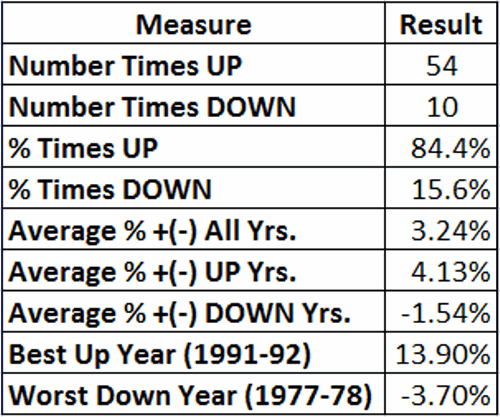Dec 26, 2013 | Seasonality
Some seasonal trends have shown a tendency to persist through time (hence the use of the word “trend”, I guess). As it turns out we are at the cusp of one of “those times” right now. It is sitting there like a wrapped gift under the tree with our name on it – so let’s not waste any time diving in.
December-January Changeover
The period we will look at encompasses the last 4 trading days of December and the first 3 trading days of the following January. In other words, a contiguous 7 day trading period during which the stock market has showed a tendency to behave in a bullish manner.
Now given the persistence of the recent market run up, many may be a little leery of diving in here. Which I understand. Still, the numbers are what they are, so let’s take a look.
The Test
So as not to make it easy on ourselves, this test begins in December 1933, i.e., in the early days off the great Depression. We will buy the Dow Jones industrials Average at the close of the fifth to last trading day of the year and sell at the close of the third trading day of January. This test assumes no interest is earned while out of the market so that we measure only the performance during the supposedly bullish period.
The Results
Figure 1 displays the growth of $1,000 invested in the Dow every year since 1933 during the seven trading days just described.
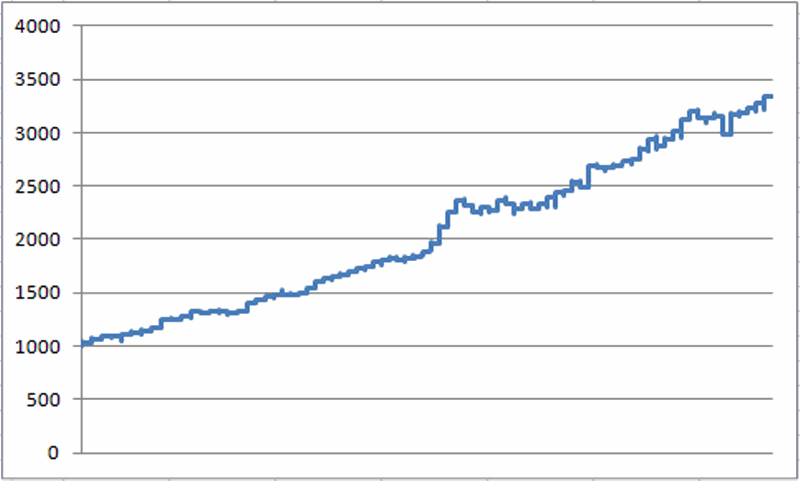
Figure 1 – Growth of $1,000 invested in Dow Industrials during bullish 7-day period (1933-present)
Two anecdotal comments from a quick perusal of the graph in Figure 1:
-There is clearly a lower left to upper right trend, which is what we want to see in any equity curve
-It is by no means “perfect”, so a little closer analysis of the numbers may be useful in convincing ourselves that this trend might actually be useful. So in order to gain some perspective, let’s compare the performance of the Dow during this time period versus Dow performance for all trading days.
A few figures of note:
-System average daily performance is +0.22% versus +0.03% for all trading days (7.53 times greater).
-System median daily performance is +0.17% versus +0.03% for all trading days (4.00 times greater).
-338 out of 560 system trading days showed a gain (60.4%).
-10,946 out of all 20,922 trading days showed a gain (52.3%).
-Average 7-day return only during system days = +1.55%.
-Average 7-day return for all trading days = +0.20%.
-The 7-day system period has showed a gain in 62 of the past 80 years (or 77.5% of the time)
One other thing to note is that returns (and albeit risk) is enhanced by trading leveraged funds such as ticker UDPIX (Profunds UltraDow) or UDOW (ProShares UltraDow30 ETF).
Summary
So is the Dow destined to be higher at the close on January 6, 2014 than it was at the close on December 24th, 2013? Not necessarily. But that would seem to be the way to bet.
Jay Kaeppel
Chief Market Analyst at JayOnTheMarkets.com and AIQ TradingExpert Pro (http://www.aiq.com) client
Jay has published four books on futures, option and stock trading. He was Head Trader for a CTA from 1995 through 2003. As a computer programmer, he co-developed trading software that was voted “Best Option Trading System” six consecutive years by readers of Technical Analysis of Stocks and Commodities magazine. A featured speaker and instructor at live and on-line trading seminars, he has authored over 30 articles in Technical Analysis of Stocks and Commodities magazine, Active Trader magazine, Futures & Options magazine and on-line at www.Investopedia.com.
Dec 7, 2013 | chart patterns, Seasonality, trading strategies
Seasonality is always on a traders radar in December. The Santa Claus rally and all.
In this seasonal vein, I ran a scan of a decent database of liquid stocks with the following idea in mind.
1) The percentage return for the last 20 trading days of the year.
2) Look back the last 8 years
3) Only show me stocks that have either all positive or all negative returns in those 8 years
As the Santa Claus rally is a seasonal feature of the markets it made sense to me to find stocks that do the same thing. Might as well get as many odds in my favor as I can.
So here’s what I found.
17 stocks have had positive returns in the last 20 trading days of the year, 8 years in a row.
The top performer was AAR Corp – symbol AIR. It’s average return over the last 8 years was a whopping 13.98%. Pretty impressive for 20 days. More impressive was the consistency. The range of returns was between 7% and 23%, so no 98% wild card distorting the pattern.
Of course there’s never any guarantee this will continue, but it’s impressive to see.
Dec 7, 2013 | Seasonality, trading strategies
Seasonality is always on a traders radar in December. The Santa Claus rally and all.
In this seasonal vein, I ran a scan of a decent database of liquid stocks with the following idea in mind.
1) The percentage return for the last 20 trading days of the year.
2) Look back the last 8 years
3) Only show me stocks that have either all positive or all negative returns in those 8 years
As the Santa Claus rally is a seasonal feature of the markets it made sense to me to find stocks that do the same thing. Might as well get as many odds in my favor as I can.
So here’s what I found.
17 stocks have had positive returns in the last 20 trading days of the year, 8 years in a row.
The top performer was AAR Corp – symbol AIR. It’s average return over the last 8 years was a whopping 13.98%. Pretty impressive for 20 days. More impressive was the consistency. The range of returns was between 7% and 23%, so no 98% wild card distorting the pattern.
Of course there’s never any guarantee this will continue, but it’s impressive to see.
AIQ TradingExpert Pro’s Expert Design Studio was used to create the scan. FREE trial at
http://aiqsystems.com/PLSbrochure2.htm
Nov 19, 2013 | ETFs, options, Seasonality
AIQ Opening bell contributor and TradingExpert Pro client, jay Kaeppel has a FREE webinar in association with the Market Technicians Association. details are below
On Wednesday, November 20th, 2013, the MTA’s Educational Web Series continues with another free educational webcast event at 12 PM Eastern / 9 AM Pacific. This week, we will feature…
“Finding Exceptional Opportunities with ETFs, Options, & Seasonal Trends”
with Jay Kaeppel
With all of the trading vehicles and great opportunities now available, there has never been a better time to be a trader. The key to success is to identify and take advantage of exceptional opportunities. In this fast-paced session, market veteran and author Jay Kaeppel reveals a handful of unique trading methods that you have likely never considered. Each method details a simple, objective and highly effective plan of action. Take a journey off the beaten path and discover simple trading strategies designed to succeed in the long run.
the link howver will not be live until 11/20/2013
Nov 14, 2013 | Seasonality, trading strategies
OK I’ll admit I am a little early with this one. But maybe not as early as you might think. In fact, as I was out driving I saw the first house in my neighborhood to have Christmas lights up…and lit. Hey, desperate times I guess.
While the stock market continues to push to new highs, “morale” is not quite what one might expect. This may be due in part to the fact that it is near impossible to peruse the financial media these days and not come away with a sense of foreboding, given all of the warnings and admonitions and liberal use of word like “frothy” and “bubble.” And make no mistake, I have voiced a few concerns recently myself and have gone so far as to suggest that investors consider hedging with VXX call options (http://jayonthemarkets.com/2013/10/30/is-vxx-issuing-a-warning/) from time to time.
Still, as a person who has been involved in the financial markets for a while I understand the power of the trend. So despite all of my personal concerns about the economy, debt, etc., etc., 2013 has been good to “go with the flow” kind of people. In the short-term, the stock market does appear to be a bit “overbought” and perhaps “due for a correction.” But while anything can happen, history suggests that people who are looking for a stock market collapse before the end of the year may be disappointed. Cue the Christmas music.
The Santa Claus Rally
As I define it, the Santa Claus rally time period:
-Begins at the close of trading on the Friday before Thanksgiving.
-Extends through the close of the third trading day of January.
And that’s all there is to it.
So how has the stock market performed during this period in the past? I am so glad you asked.
Figure 1 displays the growth of $1,000 invested in the Dow Jones Industrials Average only during the pre-Thanksgiving through post-New Year’s period I just described, starting in November 1949.
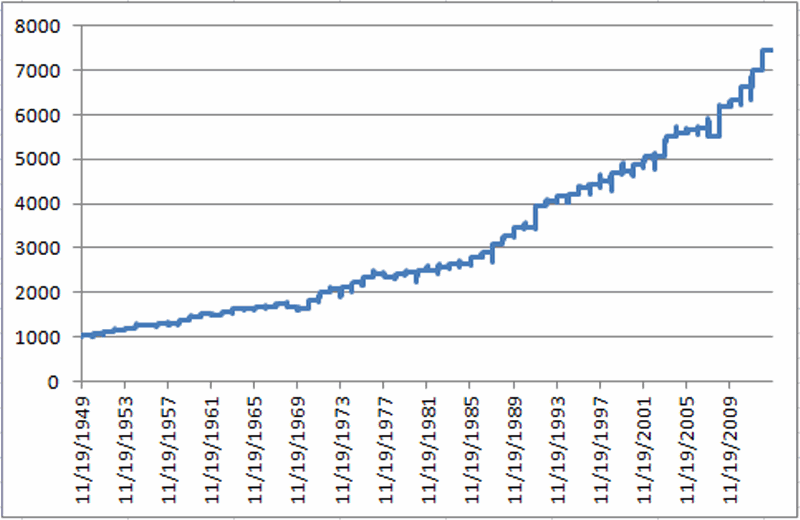
Figure 1 – Growth of $1,000 invested in Dow Jones Industrials during Santa Claus Rally period (1949-2012)
Figure 2 displays some important figures regarding this performance.
Figure 2 – Stock Market Performance during Santa Claus Rally Time Period
One other thing to note is that this Santa Claus Rally time period has witnessed an advance by the Dow during 26 of the last 28 and 32 of the last 35 years. It’s tough to the beat that kind of consistency.
Summary
So does all of this mean that “you can’t lose” trading stocks during this “sure thing” time period guaranteed to generate “above average, risk free” returns? Ah, if only. All any of this really means is that stocks have performed well during this time period in the past. What will happen this year remains to be seen.
Still, the real point is that investors may be wise to give the bullish case every benefit of the doubt starting in late November.
Jay Kaeppel
Chief Market Analyst at JayOnTheMarkets.com and AIQ TradingExpert Pro (http://aiq.com) client
Jay has published four books on futures, option and stock trading. He was Head Trader for a CTA from 1995 through 2003. As a computer programmer, he co-developed trading software that was voted “Best Option Trading System” six consecutive years by readers of Technical Analysis of Stocks and Commodities magazine. A featured speaker and instructor at live and on-line trading seminars, he has authored over 30 articles in Technical Analysis of Stocks and Commodities magazine, Active Trader magazine, Futures & Options magazine and on-line at www.Investopedia.com.
P.S. For all of you “numbers geeks” out there, the annual performance during the Santa Claus Rally Time period appears below
| Period Ending |
DJIA % +(-) |
|
1/5/50
|
3.6
|
|
1/4/51
|
4.0
|
|
1/4/52
|
3.9
|
|
1/6/53
|
4.6
|
|
1/6/54
|
2.9
|
|
1/5/55
|
5.1
|
|
1/5/56
|
0.2
|
|
1/4/57
|
3.7
|
|
1/6/58
|
(0.0)
|
|
1/6/59
|
5.7
|
|
1/6/60
|
5.8
|
|
1/5/61
|
3.2
|
|
1/4/62
|
(1.0)
|
|
1/4/63
|
5.0
|
|
1/6/64
|
5.0
|
|
1/6/65
|
(1.2)
|
|
1/5/66
|
3.0
|
|
1/5/67
|
(0.5)
|
|
1/4/68
|
4.3
|
|
1/6/69
|
(3.1)
|
|
1/6/70
|
(2.4)
|
|
1/6/71
|
10.0
|
|
1/5/72
|
11.6
|
|
1/4/73
|
3.4
|
|
1/4/74
|
2.0
|
|
1/6/75
|
3.6
|
|
1/6/76
|
6.0
|
|
1/5/77
|
3.1
|
|
1/5/78
|
(3.7)
|
|
1/4/79
|
3.6
|
|
1/4/80
|
1.6
|
|
1/6/81
|
1.5
|
|
1/6/82
|
0.9
|
|
1/5/83
|
2.3
|
|
1/5/84
|
2.5
|
|
1/4/85
|
(0.3)
|
|
1/6/86
|
5.7
|
|
1/6/87
|
4.3
|
|
1/6/88
|
6.5
|
|
1/5/89
|
6.2
|
|
1/4/90
|
5.4
|
|
1/4/91
|
0.6
|
|
1/6/92
|
13.9
|
|
1/6/93
|
2.4
|
|
1/5/94
|
2.8
|
|
1/5/95
|
0.9
|
|
1/4/96
|
3.7
|
|
1/6/97
|
1.5
|
|
1/6/98
|
1.8
|
|
1/6/99
|
4.2
|
|
1/5/00
|
1.1
|
|
1/4/01
|
2.7
|
|
1/4/02
|
4.0
|
|
1/6/03
|
(0.4)
|
|
1/6/04
|
9.5
|
|
1/5/05
|
1.3
|
|
1/5/06
|
1.1
|
|
1/5/07
|
0.4
|
|
1/4/08
|
(2.9)
|
|
1/6/09
|
12.0
|
|
1/6/10
|
2.5
|
|
1/5/11
|
4.6
|
|
1/5/12
|
5.3
|
|
1/4/13
|
6.7
|
Nov 6, 2013 | Seasonality, sector funds, trading strategies
This post is more of an FYI than a specific call to action, still a reasonably good trend is a reasonably good trend.
As many investors know by now the November 1st into May time period has historically been very good for the stock market. One of the better performing sectors during this time period has tended to be the semiconductor/electronics sectors. Among tickers worthy of analysis are:
-FSELX (Fidelity Select Electronics mutual fund)
-SMH (HOLDRs Semiconductor ETF)
In a nutshell, the semiconductor/electronics sectors tend to perform well between October 31st and April 30th. The results for FSELX since October 1994 appear in Figure 1.
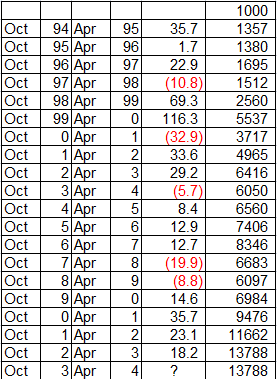
Figure 1 – FSELX Performance October 31 to April 30
A chart of the annual growth of $1,000 appears in Figure 2.
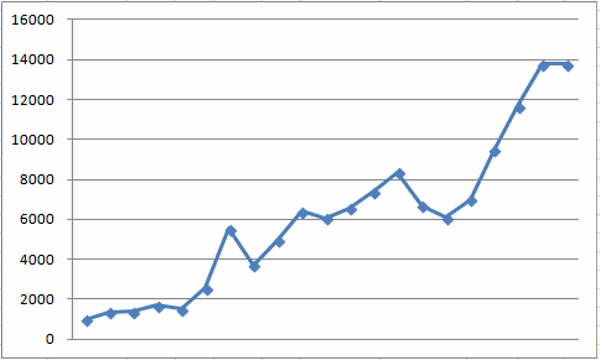
Figure 2 – $1,000 invested in FSELX 10/31 through 4.30 since 10/1994
In a nutshell:
-FSELX has been up 14 times (74%) and down 5 times (26%).
-The average gain was +18.7% and the median gain was +13.7%.
-The worst declines were -32.9% during 2000 to 2001 and -19.9% during 2007 to 2008, so remember that there is definitely risk involved
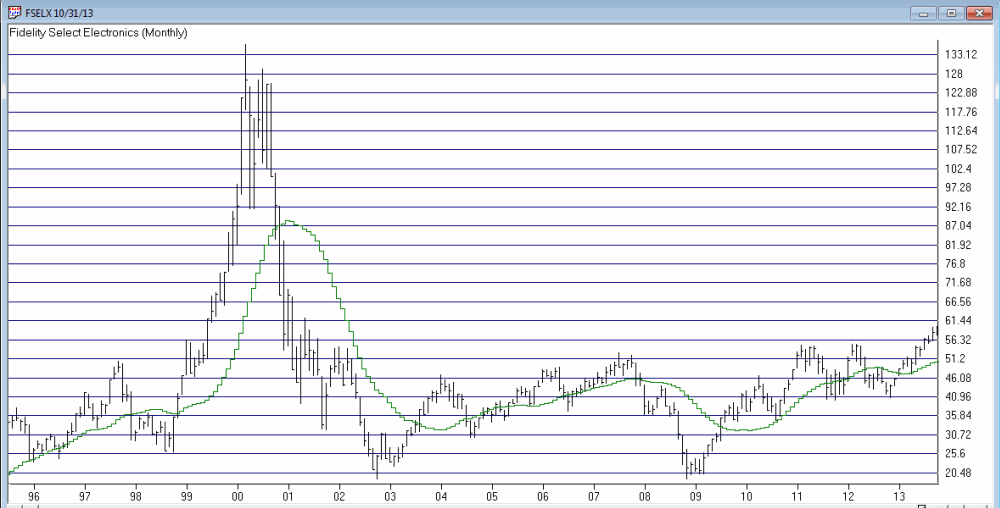 Figure 3 – Fidelity Select Electronics (Ticker FSELX) (Courtesy: AIQ TradingExpert)
Figure 3 – Fidelity Select Electronics (Ticker FSELX) (Courtesy: AIQ TradingExpert)
Summary
Please do not read this post and think “Aha, semiconductor/electronic stocks are sure to rally.” That is not the implication I am trying to make. Simply remember that the “trend is your friend” and that this sector tends to perform well during this time period. As long as these stocks act well it may be wise to give the bullish case the benefit of the doubt.
ay Kaeppel
Chief Market Analyst at JayOnTheMarkets.com and AIQ TradingExpert Pro (http://aiq.com) client
Jay has published four books on futures, option and stock trading. He was Head Trader for a CTA from 1995 through 2003. As a computer programmer, he co-developed trading software that was voted “Best Option Trading System” six consecutive years by readers of Technical Analysis of Stocks and Commodities magazine. A featured speaker and instructor at live and on-line trading seminars, he has authored over 30 articles in Technical Analysis of Stocks and Commodities magazine, Active Trader magazine, Futures & Options magazine and on-line at www.Investopedia.com.




